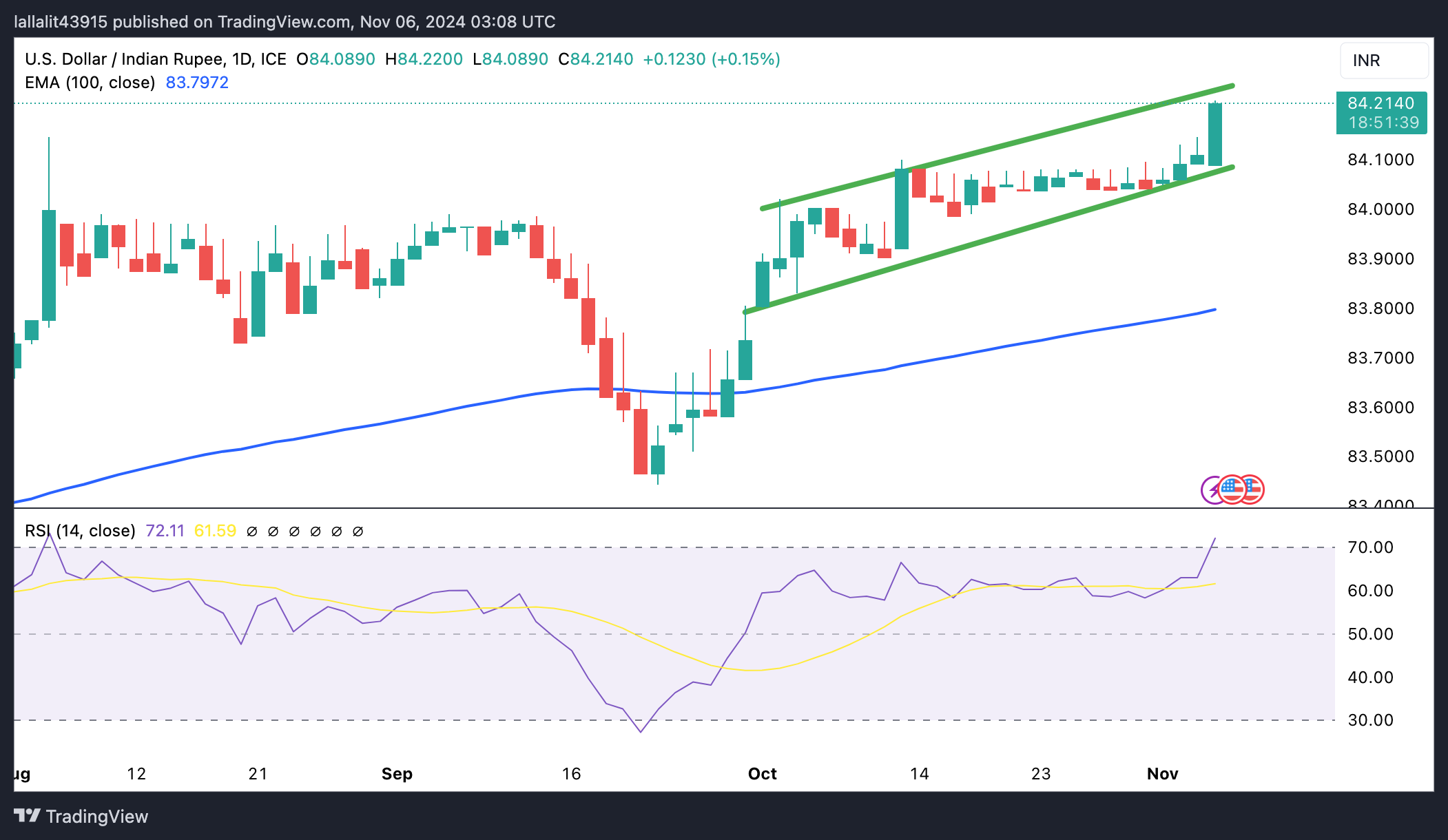- The Indian Rupee gains ground in the Asian session on Thursday.
- Strengthening USD and rising bond yields could limit INR rises.
- The US Fed’s interest rate decision will be in the spotlight on Thursday.
Indian Rupee (INR) recovers on Thursday. However, the local currency’s rise could be limited amid a rally in the US dollar (USD) and rising bond yields, which are boosted by Donald Trump’s victory in the US presidential election. US Market participants expect the INR to trade in a range on Thursday as the Reserve Bank of India (RBI) is expected to intervene in the market by selling USD to prevent excessive volatility.
Meanwhile, persistent foreign fund outflows amid bond and forex market volatility could put some selling pressure on the INR in the near term. Investors will closely monitor the US Federal Reserve (Fed) meeting on Thursday, where an interest rate cut of 25 basis points (bp) is expected. Additionally, weekly US Initial Jobless Claims will be released.
Daily Market Summary: Indian Rupee Rises, But Upside Potential Seems Limited
- “The rupee has been trading in a tight range for the last two years and was also a bit overvalued. But now, since the dollar index is rising and other Asian currencies are depreciating, there will be an impact on the rupee as well,” said Gopal Tripathi, head of treasury and capital markets at Jana Small Finance Bank.
- The HSBC India Services PMI rose to 58.5 in October from 57.7 in September, beating a preliminary estimate of 58.3.
- “During October, India’s services sector saw strong expansions in output and consumer demand, as well as job creation,” said Pranjul Bhandari, chief India economist at HSBC.
- A narrow majority of economists in a Reuters poll expected the RBI to cut rates by 25 bps to 6.25% in December.
- Financial markets are now pricing in a nearly 98% chance of a quarter-point taper and about a 70% chance of a similarly sized move in December, according to the CME’s FedWatch tool. However, traders have begun to reduce bets on the number of rate cuts expected next year.
Technical Analysis: USD/INR constructive outlook remains unchanged, focus on overbought RSI
The Indian Rupee recovers on the day. Technically, the positive view on the USD/INR pair prevails as the pair remains above the 100-day exponential moving average (EMA) on the daily time frame. However, the 14-day Relative Strength Index (RSI) is trading above the midline near 73.45, indicating an overbought RSI condition. This suggests that further consolidation cannot be ruled out before positioning for any near-term appreciation in USD/INR.
The crucial resistance level for USD/INR emerges near the upper boundary of the uptrend channel at 84.30. The additional upside filter to watch is 84.50, followed by the psychological level of 85.00.
On the other hand, the lower boundary of the trend channel and the October 11 high in the 84.05-84.10 zone act as an initial support level for the pair. A break of this level could pave the way towards 83.80, the 100-day EMA. Extended losses could see a drop to 83.46, the September 24 low.
Indian Rupee FAQs
The Indian Rupee (INR) is one of the currencies most sensitive to external factors. The price of crude oil (the country relies heavily on imported oil), the value of the US Dollar (most trade is done in US dollars), and the level of foreign investment are all influential factors. The direct intervention of the Reserve Bank of India (RBI) in the foreign exchange markets to keep the exchange rate stable as well as the level of interest rates set by the RBI are other important factors influencing the Rupee. .
The Reserve Bank of India (RBI) actively intervenes in foreign exchange markets to maintain a stable exchange rate and help facilitate trade. Furthermore, the RBI tries to keep the inflation rate at its target of 4% by adjusting interest rates. Higher interest rates tend to strengthen the Rupee. This is due to the role of the “carry trade”, in which investors borrow in countries with lower interest rates to park their money in countries that offer relatively higher interest rates and profit from the difference.
Macroeconomic factors that influence the value of the Rupee include inflation, interest rates, economic growth rate (GDP), trade balance and foreign investment inflows. A higher growth rate can lead to more investment abroad, increasing demand for the Rupee. A less negative trade balance will eventually lead to a stronger Rupee. Higher interest rates, especially real rates (interest rates minus inflation) are also positive for the Rupee. A risk environment can lead to higher inflows of foreign direct and indirect investment (FDI and FII), which also benefit the Rupee.
Higher inflation, particularly if it is comparatively higher than other countries, is generally negative for the currency as it reflects a devaluation through excess supply. Inflation also increases the cost of exports, leading to more rupees being sold to buy foreign imports, which is negative for the Indian Rupee. At the same time, higher inflation usually leads the Reserve Bank of India (RBI) to raise interest rates and this can be positive for the Rupee, due to increased demand from international investors. The opposite effect applies to lower inflation.
Source: Fx Street
I am Joshua Winder, a senior-level journalist and editor at World Stock Market. I specialize in covering news related to the stock market and economic trends. With more than 8 years of experience in this field, I have become an expert in financial reporting.








